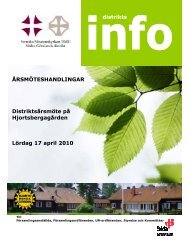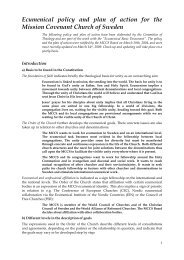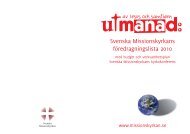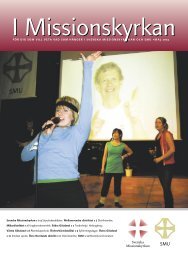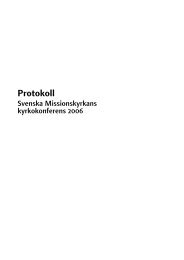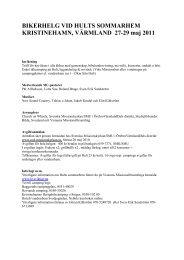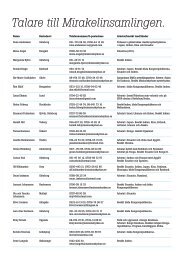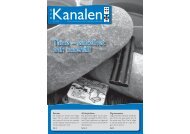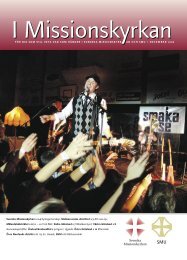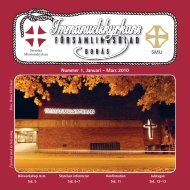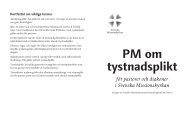Mission and Revolution in Central Asia - Svenska Missionskyrkan
Mission and Revolution in Central Asia - Svenska Missionskyrkan
Mission and Revolution in Central Asia - Svenska Missionskyrkan
Create successful ePaper yourself
Turn your PDF publications into a flip-book with our unique Google optimized e-Paper software.
His estimates can be compared to the ones given by Owen Lattimore which oscillate between<br />
two <strong>and</strong> eight million people. Maybe four million people is the most probable figure he says.<br />
Accord<strong>in</strong>g to Lattimore, the two districts where the missionaries worked, Kashgar <strong>and</strong><br />
Jarkend, might have had a total population of 1.5 million people. 32 The two cities, not<br />
<strong>in</strong>clud<strong>in</strong>g the countryside around them, were big cities <strong>in</strong> the modern sense. Jarkend, the<br />
larger of the two, had approximately 100 000 <strong>in</strong>habitants, <strong>and</strong> Kashgar around 90 000. It is<br />
true to say that the Swedish <strong>Mission</strong> worked <strong>in</strong> a very densely populated area.<br />
The population was mixed. In the prov<strong>in</strong>ce there were thirteen different ethnic groups.<br />
There were Kazakhs, Mongolians <strong>and</strong> other large m<strong>in</strong>ority groups. They will however not be<br />
taken up any more here as they were not of significance for the mission work. Only a few<br />
groups <strong>in</strong> the southern part where the mission was actively engaged will be mentioned here.<br />
The Ch<strong>in</strong>ese, masters of the country, made up perhaps no more than 5-10 per cent of the<br />
entire population. 33 Accord<strong>in</strong>g to Lattimore the Ch<strong>in</strong>ese belonged to four categories: 1.<br />
Immigrants from <strong>Central</strong> Ch<strong>in</strong>a, 2. Tradesmen, 3. Soldiers <strong>and</strong> 4. Crim<strong>in</strong>als deported from<br />
Ch<strong>in</strong>a. 34<br />
The <strong>Central</strong> Government encouraged the Ch<strong>in</strong>ese <strong>in</strong> the coastal prov<strong>in</strong>ces to move here.<br />
They found it important to have as many reliable Ch<strong>in</strong>ese as possible liv<strong>in</strong>g <strong>in</strong> Eastern<br />
Turkestan form<strong>in</strong>g a barrier aga<strong>in</strong>st the <strong>in</strong>creas<strong>in</strong>g migration from Russia. 35 Many of these<br />
Ch<strong>in</strong>ese immigrants had made a fortune <strong>in</strong> their “new homel<strong>and</strong>”. Their salaries <strong>in</strong> Eastern<br />
Turkestan would generally be three times the amount they were paid <strong>in</strong> other Ch<strong>in</strong>ese<br />
prov<strong>in</strong>ces. 36 Many of them however did not feel at home so far away from where their<br />
ancestors lived. In the middle of their material affluence they were plagued by spiritual<br />
distress <strong>and</strong> deep rootlessness. The missionaries were conv<strong>in</strong>ced that these immigrants were<br />
more to be pitied than the rest of the population. They had left their home prov<strong>in</strong>ces <strong>and</strong> the<br />
l<strong>and</strong> of their ancestors beh<strong>in</strong>d <strong>in</strong> order to seek their fortune here. They had various social<br />
backgrounds, but they all found themselves cut off from the ties of tradition <strong>and</strong> family life.<br />
Dur<strong>in</strong>g the <strong>Mission</strong> period the Ch<strong>in</strong>ese had time to arrive <strong>in</strong> the area <strong>and</strong> to start families.<br />
Their children came to look upon themselves as natives <strong>in</strong> the country. Many of these boys<br />
attended the mission schools. Not only were they gifted <strong>and</strong> positive children, accord<strong>in</strong>g to<br />
the missionaries, but they often learnt the Turkish language beside their own mother tongue. 37<br />
The future of the <strong>Mission</strong> depended on these children.<br />
To other Ch<strong>in</strong>ese, Turkestan was “Siberia". Crim<strong>in</strong>als from Ch<strong>in</strong>a proper were deported<br />
there. Yet others had fled there to escape from justice. Mrs. Lattimore describes the Ch<strong>in</strong>ese<br />
here as “real scoundrels <strong>and</strong> b<strong>and</strong>its, rabble <strong>and</strong> scum com<strong>in</strong>g from everywhere.” It was not<br />
surpris<strong>in</strong>g, she po<strong>in</strong>ts out, that the Governor was said to be extremely severe, rul<strong>in</strong>g his<br />
prov<strong>in</strong>ce like a dictator. 38 Törnquist is of the same op<strong>in</strong>ion concern<strong>in</strong>g many Ch<strong>in</strong>ese. “On the<br />
32<br />
Lattimore, 1920, p. 103. In 1940 however, Lattimore gives the figure 3.500.000. (Lattimore, 1940, p. 11.)<br />
Douclas Jacson <strong>in</strong>dicates for 1953 the figure of 4.900.000. (Jacson, 1962, p. 12.) W.J. Drew has stated the same<br />
number for the year 1953. In 1967, the population had grown to 8.000.000. (Drew, 1968, p. 208.) The great<br />
<strong>in</strong>crease start<strong>in</strong>g <strong>in</strong> the 1940s cont<strong>in</strong>u<strong>in</strong>g <strong>in</strong>to the 1960s was due to a massive migration from <strong>Central</strong> Ch<strong>in</strong>a.<br />
Jarkend was the centre of Indian-British commerce. (Mirsky, 1977, p. 141.)<br />
33<br />
Högberg writes <strong>in</strong> his book, Ett och annat från K<strong>in</strong>esiska Turkestan, p. 14 f, that the number of Ch<strong>in</strong>ese could<br />
hardly atta<strong>in</strong> 3 %. This low portion of the population was someth<strong>in</strong>g he wanted to prove because he was aga<strong>in</strong>st<br />
a special mission among the Ch<strong>in</strong>ese <strong>in</strong> Eastern Turkestan. See also Gore, 1980, p. 292, <strong>in</strong>dicat<strong>in</strong>g 5 %.<br />
34<br />
Lattimore, 1950, p. 50.<br />
35<br />
Inspection m<strong>in</strong>utes, 1913. The trade with opium was flourish<strong>in</strong>g practically without restra<strong>in</strong>t. Eastern<br />
Turkestan did not however cultivate the poppy, but the article was imported for <strong>in</strong>stance from Western Turkestan<br />
<strong>in</strong> Russia. (Etherton, 1923, p. 93 f.)<br />
36<br />
Lundahl, 1917, p. 100 ff.<br />
37<br />
Ibid. P. 106.<br />
38<br />
Lattimore, 1935, p. 114.<br />
5



